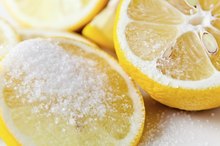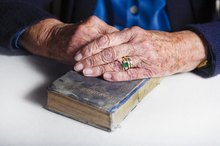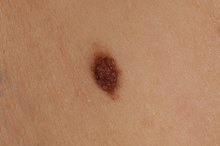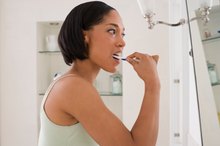How to Treat Skin Cancer With Sodium Bicarbonate
According to the American Cancer Society, skin cancer is the most common form of cancer, accounting for more than half of the cancer cases in the United States. With a survival rate of 91 to 99 percent, many people are cured by simply having the affected area surgically removed. However, for those who would like to avoid this procedure, there may be an inexpensive and easy home treatment option for skin cancer--baking soda. There are no scientific studies in the United States which support this claim, but there is a reasonable quantity of anecdotal evidence that suggests the application of sodium bicarbonate to an external area afflicted with basal cell or squamous cell carcinoma may reduce or even remove cancer non-surgically.
Wash the area to be treated with warm water and soap, rinsing thoroughly.
How to Get Rid of Freckles With Vitamin C
Learn More
Place baking soda into a small bowl and add just enough water to make a thick paste. Stir with a tongue depressor until well blended.
Apply a generous amount of the baking soda paste to the affected area with the tongue depressor. With a gloved finger, gently rub the baking soda into the lesion.
How to Treat Discoloration & Brown Spots With Glycolic Acid
Learn More
Add more baking soda paste to the lesion, creating a think layer that completely covers the affected area, and cover with a bandage.
Leave bandage in place for two hours. Then rinse the baking soda away with cool water and cleanse the affected area with hydrogen peroxide.
Repeat this treatment four to six times a day for one week, applying a new coat of baking soda paste and leaving in place to dry for several hours before rinsing and cleaning with peroxide.
Tips
When you put the baking soda onto an open lesion, it will burn. This is because it is highly alkaline. If you find the discomfort level unbearable, try increasing the amount of water in your baking soda paste, though the weaker the mixture, the longer it is likely to take to see results. The affected area is likely to show increased signs of redness and inflammation on the first day of treatment. This can be reduced by the application of cold compresses or ice packs.
Warnings
If your lesion seems to be getting larger rather than smaller after a week of baking soda treatment, follow a course of traditional medication.
Related Articles
References
- National Center for Biotechnology Information. PubChem. Compound Summary for CID 516892, Sodium bicarbonate.
- Hadzic M, Eckstein ML, Schugardt M. The impact of sodium bicarbonate on performance in response to exercise duration in athletes: A systematic review. J Sports Sci Med. 2019;18(2):271-281
- Ciancio SG. Baking soda dentifrices and oral health. J Am Dent Assoc. 2017;148(11S):S1-S3. doi:10.1016/j.adaj.2017.09.009
- Birt D, From L, Main J. Diagnosis and management of long-standing benign oral ulceration. Laryngoscope. 1980 May;90(5 Pt 1):758-68. PMID: 6990140.
- American College of Gastroenterology. Acid reflux.
- Hughes A, Brown A, Valento M. Hemorrhagic encephalopathy from acute baking soda ingestion. West J Emerg Med. 2016;17(5):619-22. doi:10.5811/westjem2016.6.30713
- Al-Abri SA, Olson KR. Baking soda can settle the stomach but upset the heart: Case files of the Medical Toxicology Fellowship at the University of California, San Francisco. J Med Toxicol. 2013;9(3):255-8. doi:10.1007/s13181-013-0300-4
- Krustrup P, Ermidis G, Mohr M. Sodium bicarbonate intake improves high-intensity intermittent exercise performance in trained young men. J Int Soc Sports Nutr. 2015;12:25. doi:10.1186/s12970-015-0087-6
- McNaughton LR, Siegler J, Midgley A. Ergogenic effects of sodium bicarbonate. Curr Sports Med Rep. 2008;7(4):230-6. doi:10.1249/JSR.0b013e31817ef530
- de Brito-Ashurst I, Varagunam M, Raftery MJ, Yaqoob MM. Bicarbonate supplementation slows progression of CKD and improves nutritional status. J Am Soc Nephrol. 2009;20(9):2075-84. doi:10.1681/ASN.2008111205
- Yang M, Zhong X, Yuan Y. Does baking soda function as a magic bullet for patients with cancer? A mini review. Integr Cancer Ther. 2020;19:1534735420922579. doi:10.1177/153473542092257
- Yang T, Doherty J, Zhao B, Kinchla AJ, Clark JM, He L. Effectiveness of commercial and homemade washing agents in removing pesticide residues on and in apples. J Agric Food Chem. 2017;65(44):9744-9752. doi:10.1021/acs.jafc.7b03118
- Qamaruz-Zaman N, Kun Y, Rosli RN. Preliminary observation on the effect of baking soda volume on controlling odour from discarded organic waste. Waste Manag. 2015;35:187-90. doi:10.1016/j.wasman.2014.09.017
- Al-Abri SA, Kearney T. Baking soda misuse as a home remedy: case experience of the California Poison Control System. J Clin Pharm Ther. 2014;39(1):73-7. doi:10.1111/jcpt.12113
- Di Iorio BR, Bellasi A, Raphael KL, Santoro D, Aucella F, Garofano L, Ceccarelli M, Di Lullo L, Capolongo G, Di Iorio M, Guastaferro P, Capasso G; UBI Study Group. Treatment of metabolic acidosis with sodium bicarbonate delays progression of chronic kidney disease: the UBI Study. J Nephrol. 2019;32(6):989-1001. doi:10.1007/s40620-019-00656-5
Tips
- When you put the baking soda onto an open lesion, it will burn. This is because it is highly alkaline. If you find the discomfort level unbearable, try increasing the amount of water in your baking soda paste, though the weaker the mixture, the longer it is likely to take to see results. The affected area is likely to show increased signs of redness and inflammation on the first day of treatment. This can be reduced by the application of cold compresses or ice packs.
Warnings
- If your lesion seems to be getting larger rather than smaller after a week of baking soda treatment, follow a course of traditional medication.
Writer Bio
Lisa Parris is a writer and former features editor of "The Caldwell County News." Her work has also appeared in the "Journal of Comparative Parasitology," "The Monterey County Herald" and "The Richmond Daily News." In 2012, Parris was honored with awards from the Missouri Press Association for best feature story, best feature series and best humor series.









